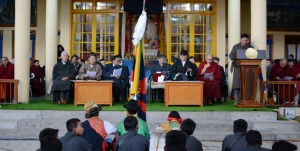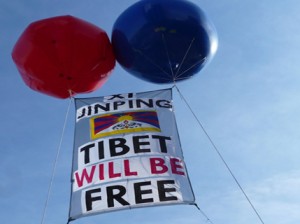Extracts from the statement made by Sikyong Dr Lobsang Sangay

Sikyong Dr Lobsang Sangay addressing the Tibetan National Uprising Day gathering
Photo: Tibet.net/Tenzin Phende
Fifty-five years ago, thousands of Tibetans spontaneously gathered on this day in Lhasa, the capital city of Tibet, to protect His Holiness the Dalai Lama and protest against Chinese occupation…The year 2020 will mark 70 years since the invasion of Tibet by the People’s Republic of China. By then, the generation of Tibetans with memories of a free Tibet will have greatly dwindled. The next generation of Tibetan leadership inside and outside Tibet has to cope with a crucial and challenging reality. Tibetans inside Tibet will have no personal memories of traditional Tibet, while Tibetans outside of Tibet will know only a life lived in exile.
As a long-term strategy, we need to build self-reliance…Our more than 50-year-old movement cannot depend solely on others to help us achieve our goals. It is time to assume individual responsibility and collective leadership and stand on our own feet. We need to build our individual and collective strengths.
The challenge we face will be in reconciling the distance and gap between life in exile and life under Chinese occupation. We will have to learn to carry forward the freedom struggle under these very different Tibetan realities and experiences, none of which are rooted in personal memories of a free Tibet. How do we achieve this? I believe that education is our most potent and realistic investment and tool. It is crucial that younger Tibetans study the language and history of the nation. It is the combination of traditional values and contemporary education that will keep our struggle vigorous, dynamic, and formidable.
The Tibetan people have risen time after time to overcome great adversities in the long history of our civilisation. Today, our sense of identity, solidarity, and dignity is deeper than ever. If we remain united, and bring the rich traditions of the elders to interplay with the innovation and dynamism of the younger generation, I firmly believe that the Chinese government will have no choice but to address our aspirations.
Extracts from the statement made by Speaker Penpa Tsering on behalf of the Tibetan Government-in-exile

Mr Penpa Tsering, Speaker of the Tibetan Parliament-in-Exile, addressing the Tibetan National Uprising Day gathering
Photo: tibet.net
For all the Tibetan compatriots who died untimely deaths, or who have suffered or who to this day continue to suffer oppression…we offer our admiration. We take this opportunity to express our appreciation to them and to praise them for their totally selfless and highly courageous deeds. We also use this occasion to offer our tribute to them; to express our solidarity with them; and, indeed, to bow in respect to them all.
The causes of the continuing protests by Tibetans in Tibet against the Chinese government, including in the form of self-immolations, are violent political repressions, cultural assimilation, economic marginalisation, ethnic discrimination, nomadic displacement, environmental destruction, and so on.
Tibet is referred to as the globe’s third pole on account of its critical importance as the source of much of the Asian rivers, for its role in global climate change, and so on. Its environmental conditions have direct impact on other environments. Nevertheless, the government of China continues to carry out in Tibet indiscriminate [developments] causing untold damage to Tibet’s natural environment.
In the monasteries, the main centres of Tibet’s religious and cultural heritage, the monks and nuns are…forced to…study the stands and policies and so on of the government of China. They are thereby being forced to turn their backs on the study, practice and teaching of their religion. As regards the displaying of visually liberating images of His Holiness the Dalai Lama for purposes of offering worship, a ban has been imposed.
The nature of the Tibetan struggle remains a resolute one of non-violence, with commitment to the Middle Way Policy, without any sort of wavering.
To all the leaders of governments, members of parliaments, organisations and private individuals, especially the central and local governments and people of India, who have provided all manners of help and support …we express heartfelt thanks.
Finally, we fervently pray that His Holiness the Dalai Lama, the spiritual lord of the Three Realms, a champion of world peace, live for a hundred eons and see all his wishes fulfilled with utmost spontaneity and that the just cause of Tibet may definitely prevail.




 Print
Print Email
Email